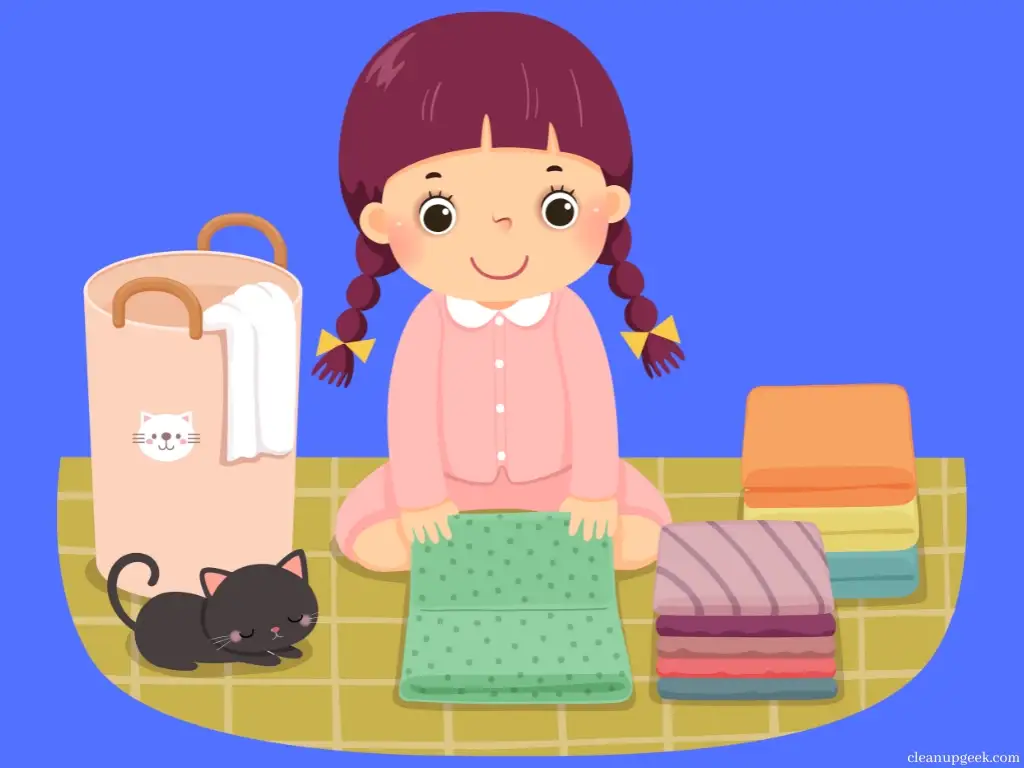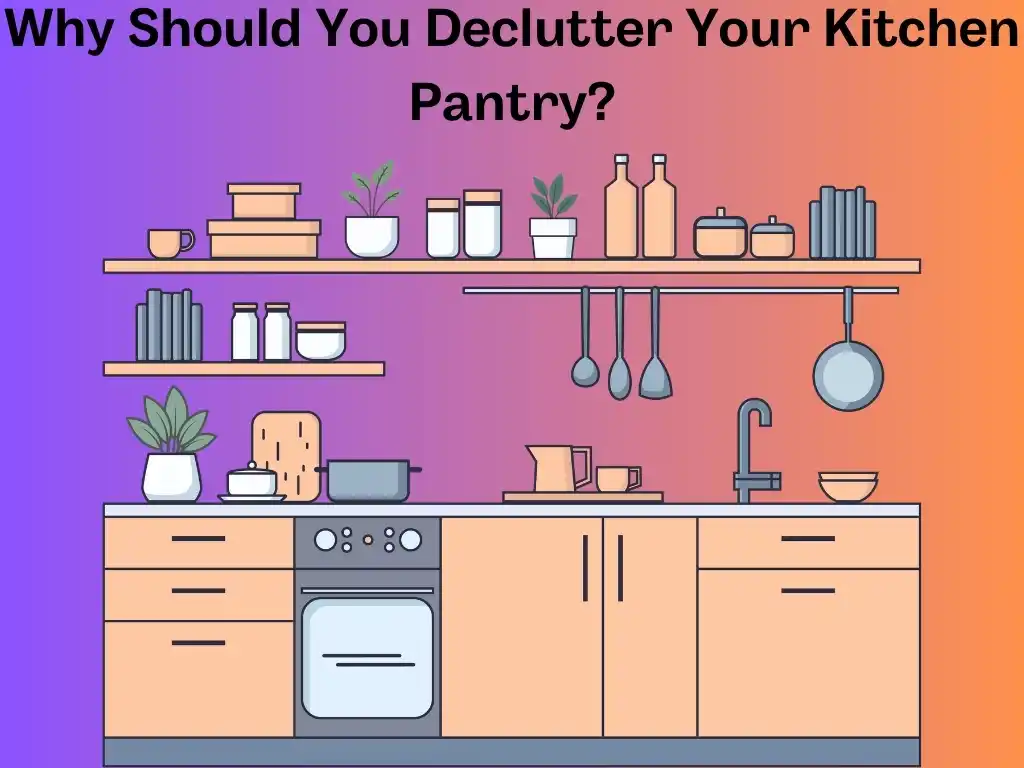Are you constantly rummaging through your kitchen pantry to find a single ingredient? On average, a cluttered pantry can lead to 30% more time spent on meal preparation.
This article will show you the incredible benefits of decluttering your kitchen space and offer easy-to-follow tips for creating a tidy and efficient pantry.
Get ready to transform your kitchen chaos into calm!
KEY INFORMATION
- Decluttering your pantry helps you find things faster, leading to less stress when cooking.
- Organizing food items and using clear containers cuts down on wasted food and money.
- Cleaning a tidy pantry is quicker and keeps pests away.
The Benefits of a Decluttered Pantry
A decluttered pantry makes it easier to find items, reduces food waste, saves time and money, and simplifies cleaning. It brings a sense of calm and efficiency to your kitchen space.
1. Easier to find items
Having a clean pantry helps you see what you have at a glance. You won’t have to move things around or dig through piles to find your baking powder or that can of beans. This means less time searching and more time cooking.
Plus, when everything has its place, putting groceries away is a breeze. With clear jars and labeled bins, you’ll know exactly where every item should go.
Keeping your kitchen shelves neat also helps track what needs restocking. Say goodbye to buying duplicates because items are now in plain sight. Imagine opening your pantry door and instantly spotting the snack or ingredient you need — it’s like having a magic cupboard that saves the day every time! Decluttering lets each item shine, making meal prep simpler and inspiring you to use what you have before it goes bad.
2. Less food waste
To reduce food waste, decluttering your kitchen pantry is essential. An organized pantry allows you to see and access all items easily, preventing forgotten or expired foods. By knowing what you have, you can plan meals efficiently and avoid overbuying groceries, ultimately saving money and reducing food waste.
Additionally, a well-organized pantry helps in maintaining an inventory of your supplies, ensuring that nothing gets lost or spoiled at the back of the shelves.
Decluttering also aids in identifying items close to the expiration date promptly. This enables you to utilize them before they go bad, contributing to a more sustainable and mindful approach towards food consumption.
3. Saves time and money
An organized kitchen pantry can help you save time and money. When everything is neatly arranged, you can easily find what you need without wasting time searching through clutter. Plus, knowing exactly what ingredients and supplies you have helps prevent buying duplicates, and saving money on groceries.
By keeping your pantry decluttered, it’s easier to take inventory of food items and plan meals efficiently, avoiding last-minute trips to the store or ordering takeout.
In addition, a well-organized pantry reduces food waste by preventing items from getting lost or forgotten at the back of shelves. You also avoid overbuying when everything is visible and accessible.
4. Simplifies cleaning
Keeping your kitchen pantry decluttered can simplify cleaning and save you time. With everything organized and easy to find, there are fewer places for dust and grime to hide, making wiping down shelves a breeze.
A clean pantry also reduces the risk of attracting pests, ensuring that your kitchen remains sanitary and safe for food storage. By streamlining your pantry organization and implementing space-saving solutions like clear containers or labeled bins, you can maintain a tidy space with minimal effort, allowing you to focus on other household tasks in no time.
Tips for Decluttering and Organizing Your Pantry
Remove everything from the pantry, clean surfaces thoroughly, declutter and group similar items, use appropriate storage solutions, label and categorize items, and keep a commitment to maintaining organization.
Ready to transform your kitchen pantry? Click here to learn more about the benefits of decluttering and organizing your space.
1. Remove everything from the pantry
Take out all items from your pantry. Start by clearing the shelves and drawers completely. Use this opportunity to inspect each item closely for expiration dates or signs of pests. Empty containers, baskets, and bins should also be removed for cleaning and sorting.
- Wipe down the shelves thoroughly. Use a mild detergent to clean any spills or stains. Consider using shelf liners for easy future maintenance.
- Sort through the items you removed from the pantry. Check expiration dates on all food products and dispose of anything past its prime.
- Group similar items together such as canned goods, spices, grains, and snacks for easy organization once everything goes back in.
- Assess the condition of containers, jars, and storage solutions. Discard any damaged or unusable ones to make room for efficient storage.
- Take inventory of what you have removed before discarding anything unnecessary or outdated.
- Wipe down all containers, jars, baskets, and bins before returning them to the pantry to maintain cleanliness.
2. Thoroughly clean surfaces
Start by removing everything from the pantry to create a clean slate. Wipe down all shelves and surfaces with a damp cloth or cleaning solution to remove any dust, spills, and crumbs.
- Clean the walls and corners of the pantry to eliminate any hidden dirt or grease.
- Pay attention to the top and bottom shelves as they tend to accumulate more debris.
- Use a mild soap solution to scrub away any sticky residue from spills or leaked food items.
- Dry all surfaces completely before returning items to prevent mold or mildew growth.
- Consider using shelf liners to make future cleaning easier and protect the pantry surfaces.
3. Declutter and group similar items
To declutter and group similar items in your pantry, follow these steps:
- Sort through canned goods, arranging them by type such as fruits, vegetables, and soups.
- Organize dry goods like pasta, rice, and grains into separate categories for easy access.
- Group baking supplies together, including flour, sugar, and baking powder.
- Consolidate snack foods like chips, nuts, and granola bars into designated sections.
- Keep spices and seasonings organized by type and frequency of use.
- Separate condiments like ketchup, mustard, and salad dressings into a specific area.
- Arrange cooking oils and vinegar in one section for quick meal preparation.
- Categorize beverages such as coffee, tea, and drink mixes to streamline your drink station.
4. Use appropriate storage solutions
To keep your pantry organized, use appropriate storage solutions that help maximize space and keep items easily accessible.
- Invest in stackable bins or baskets to group similar items together, such as baking supplies or snacks. This makes it easier to find what you need and prevents clutter.
- Utilize shelf risers to create more vertical space for canned goods, jars, and spices. This helps maximize the use of your pantry shelves.
- Consider using clear containers or jars for storing dry goods like rice, pasta, and cereal. Not only does this keep everything visible, but it also helps maintain freshness and prevent pests.
- Install door-mounted racks or hooks to hang lightweight items such as kitchen towels, aprons, or small utensils. This frees up valuable shelf space for larger items.
- Use drawer dividers or organizers to keep smaller items like food wraps, spice packets, or snack bags neatly contained within your pantry drawers.
5. Label and categorize items
Labeling and categorizing items in your pantry is essential for efficient kitchen organization. This helps you easily identify and locate items when cooking or meal planning. It reduces the chances of food items getting lost or forgotten, which can lead to less food waste.
- Use a labeling system such as adhesive labels or chalkboard labels to clearly mark containers and jars with the name of the contents.
- Categorize similar items together, such as grouping canned goods, baking supplies, snacks, and grains in designated sections or shelves.
- Consider arranging items in alphabetical order or by frequency of use to optimize accessibility and streamline the cooking process.
- Utilize clear containers for storing smaller items like spices and condiments, allowing you to see the contents at a glance without rummaging through cluttered shelves.
- Keep a master list of pantry inventory on hand to track what needs replenishing, preventing unnecessary purchases and reducing food waste.
6. Keep a commitment to maintain organization
Commit to a regular schedule for pantry organization maintenance
Things to Declutter from Your Pantry

Get rid of expired food, unused spices or seasonings, crumbs, spills, rogue food, excess bags and totes, catch-all junk, useless organizing solutions, and outdated appliances.
1. Expired food
Having expired food in your pantry can lead to health risks and contribute to clutter. It’s important to check the expiration dates on all food items regularly. Here are some things that you should declutter when it comes to expired food:
- Expired canned goods, including soups, vegetables, and fruits, can take up unnecessary space in your pantry and harbor harmful bacteria if consumed.
- Stale grains such as rice, pasta, and flour can attract pests and compromise the quality of your meals.
- Condiments past their expiration date lose flavor and nutritional value.
- Outdated baking ingredients like baking powder and yeast may not work effectively in recipes.
- Expired snacks such as chips, crackers, or cookies should be discarded to maintain a healthy snacking environment.
2. Unused spices or seasonings
Unused spices or seasonings can clutter your pantry and take up valuable space. They might lose their flavor and potency over time, so it’s important to keep them fresh for better-tasting meals. Here are some items you can declutter from your pantry to make things neater and more organized:
- Check the expiration dates on all spices and seasonings, and discard any that have passed their prime. Fresh spices can enhance the flavor of your dishes.
- Consider donating unopened or unused spices to a local food pantry or shelter. Sharing is caring, and someone else may find great use for them.
- If there are duplicates of a particular spice, consider consolidating them into one container to free up space in your pantry.
- Store frequently used spices in a convenient spice rack or drawer organizer for easy access during cooking.
- Opt for smaller containers or bags for specialty spices that are used sparingly to avoid cluttering your shelves with large, rarely-used containers.
- Keep all the labels facing forward so you can easily identify each spice and seasoning without rummaging through the entire collection every time you cook.
- Wipe down spice bottles regularly to prevent dust buildup and maintain a clean, organized pantry.
- Group similar spices together in the pantry, making it easier to locate specific ones when cooking.
3. Crumbs, spills, and rogue food
Crumbs, spills, and rogue food can attract pests and create a mess in the pantry. It can lead to food contamination and waste, making it essential to regularly clean and clear these items:
- Check for crumbs and wipe down shelves with a damp cloth. Remove any spilled or scattered food particles that may have accumulated.
- Thoroughly inspect for spillage inside containers and on the pantry floor, ensuring all areas are clean and free of debris.
- Avoid storing opened packages or bags with loose contents that can scatter around the pantry, creating untidiness.
- Regularly sweep or vacuum the pantry floor to eliminate any rogue food particles or spills, maintaining a clean environment.
- Wipe down jars, bottles, and cans to remove any sticky residue or spills that may attract pests.
4. Excess bags and totes
Excess bags and totes in your pantry take up valuable space and can contribute to a cluttered and disorganized look. They often accumulate without purpose and make it difficult to find what you need. Here are ways to declutter this area:
- Donate or recycle any unused or excess grocery bags, as they can quickly multiply and create unnecessary clutter.
- Consider using reusable shopping bags instead of hoarding disposable ones, as they’re more eco-friendly and take up less space.
- Utilize storage solutions such as collapsible totes or stackable bins for storing reusable bags, keeping them neatly contained.
5. Catch-all junk
Having catch-all junk in your pantry can make it hard to find what you need. Clutter can attract pests and lead to food waste. Here’s what to declutter:
- Random items that don’t belong in the pantry, like keys or toys.
- Unmatched containers, lids, or Tupperware that only create disarray.
- Broken or unused kitchen gadgets that take up precious space.
- Outdated coupons, menus, or old grocery lists that add unnecessary bulk.
- Excess shopping bags and packaging materials clutter up the shelves.
6. Useless organizing solutions
Useless organizing solutions can take up valuable space and make it harder to keep your pantry tidy. They might include overcomplicated storage systems that don’t suit your needs or bulky organizers that don’t fit well on the shelves. These solutions often end up causing more clutter, rather than solving the problem.
7. Outdated appliances
Outdated appliances take up space and can lead to clutter in the pantry. Old or broken appliances should be removed, such as non-functioning blenders, mixers, or slow cookers. These items can be donated, recycled, or disposed of properly. Keeping faulty appliances only adds to the disorganization in your kitchen.
Keeping appliances that are no longer useful can prevent you from having space for newer and more efficient ones. Old appliances also contribute to a messy and untidy pantry, making it difficult to find and access the items you need.
Creative and Space-Saving Ideas for Organizing Your Pantry

Utilize vertical space, hang storage units on the inside of the door, use clear containers and jars, group items in baskets or bins, and stick to a specific organizing system. Read more for effective ways to declutter and organize your kitchen pantry!
1. Utilize vertical space
Maximize your pantry’s storage capacity by making effective use of vertical space. This will help you to store more items and keep them within easy reach. Here are some practical ways to utilize vertical space in your pantry:
- Install stackable shelves or organizers to make the most of the height in your pantry. This allows you to create additional levels for storing items without taking up extra floor space.
- Use hanging racks or hooks on the inside of the pantry door to hang small items such as measuring cups, spoons, and kitchen towels. This also keeps these items easily accessible while freeing up shelf space.
- Consider installing a pegboard on one wall of the pantry to hang lightweight items such as pots, pans, and utensils. This not only creates more storage space but also adds an element of visual organization.
- Invest in tall, narrow bins or baskets to store items like baking sheets, cutting boards, and large boxes that might otherwise clutter up your shelves.
- Opt for adjustable shelving units that can be customized to fit the height of different items, allowing you to maximize every inch of space in your pantry.
- Use tension rods to create dividers on shelves, preventing smaller items from toppling over and getting lost in the back of deep shelves.
2. Hang storage units on the inside of the door
Maximize your kitchen space by hanging storage units on the inside of the door. This simple trick can help you make the most of your pantry and keep everything organized.
- Use over-the-door hanging organizers to store small items like spices, packets, or snacks. This frees up valuable shelf space and keeps frequently used items within easy reach.
- Hang wire racks or shelves on the inside of the door to store lightweight items such as wraps, foil, and plastic bags.
- Install hooks or baskets to hold cleaning supplies or small kitchen tools, making them easily accessible while keeping them out of the way.
- Consider attaching a chalkboard or whiteboard panel to jot down grocery lists, recipes, or meal plans for added functionality.
3. Use clear containers and jars
Clear containers and jars are a great way to store dry goods like pasta, rice, and cereal. When you use clear containers, you can easily see what’s inside and how much is left, which helps with meal planning. Plus, they make your pantry look tidy and organized. Here are some tips for using clear containers and jars in your pantry:
- Transfer items from their original packaging into clear containers or jars to keep them fresh longer.
- Label each container or jar with its contents and expiration date to avoid confusion.
- Stack the containers or line up the jars to maximize shelf space.
- Use uniform-sized containers for a streamlined look that makes finding items easier.
- Create a system for arranging the containers or jars by category, such as grains, snacks, or baking supplies.
- Take inventory regularly to ensure you always have what you need on hand.
4. Group items in baskets or bins
Grouping items in baskets or bins can help keep your pantry organized and make it easier to find what you need. This method can also prevent smaller items from getting lost or cluttering up the shelves. Here are ways to effectively group items in baskets or bins:
- Use clear bins or baskets to store snacks, small packets, and loose items, making it easy to see what’s inside without having to rummage through them.
- Group baking supplies such as flour, sugar, and baking soda in a labeled basket for easy access when cooking or baking.
- Keep similar canned goods together in a sturdy bin to avoid cans piling up and falling over on the shelves.
- Store different types of pasta and rice in separate containers within a larger bin for a neat and organized look.
- Use stackable bins or crates to create levels of storage for different categories of items, maximizing space and accessibility in your pantry.
5. Stick to a specific organizing system
To keep your pantry organized, it’s important to stick to a specific organizing system. Here are some tips to help you maintain an efficient and functional pantry:
- Categorize items by type, such as canned goods, baking supplies, snacks, and spices. This makes it easier to locate items and prevents clutter.
- Utilize storage containers or bins to group similar items together. Clear containers allow you to see the contents easily and help maintain order.
- Arrange items in a way that makes sense for your cooking habits and frequency of use. Keep frequently used items within easy reach.
- Label all containers and shelves to ensure everything has its designated place. This helps family members find and return items properly.
- Regularly review and adjust your organizing system as needed, especially after grocery shopping or cooking projects.
6. Take inventory regularly
Regularly taking inventory of your pantry and kitchen supplies is essential for maintaining an organized space. This practice helps you stay aware of what items you have, their quantities, and their expiration dates.
- Check for expired food items and dispose of them to maintain freshness in your pantry.
- Assess the quantity of staple ingredients like flour, sugar, and rice to ensure you never run out during meal preparation.
- Organize your inventory by categories such as grains, canned goods, spices, and snacks to make it easier to find what you need.
- Use a marker or labels to indicate the purchase or expiration dates on items for easy tracking.
- Keep track of any empty containers or storage solutions that need refilling or replacing.
- Consider creating a digital or physical inventory list to help you keep track of your pantry stock efficiently.
- Utilize this opportunity to rearrange items so that frequently used products are easily accessible, while infrequently used ones are stored out of the way.
- By regularly taking inventory, you can identify any missing essentials before running low and plan your grocery shopping accordingly.
Conclusion and final thoughts
In conclusion, decluttering your kitchen pantry can make finding items easier. It reduces food waste and saves you time and money. A clean and organized pantry simplifies cleaning and promotes healthier eating habits.
So, get started on decluttering to reap these benefits in your kitchen.
FAQs

1. Why is it good to declutter your kitchen pantry?
Decluttering your kitchen pantry helps you neaten up the space, making it easier for you to find and organize your food and supplies.
2. What are some benefits of cleaning out my pantry shelves?
When you clean out your pantry shelves, you create more room for storing things. It also helps keep bugs away and makes cooking faster because everything is easy to find.
3. How do I start organizing my kitchen cabinets?
To organize your kitchen cabinets, first take everything out and decide what to keep. Then clean the shelves and put back only the items you use, systematize them so that they’re easy to reach.
4. Can decluttering appliances help my kitchen look better?
Yes! When you get rid of unneeded kitchen appliances, there’s more space on the counters, which helps make your whole kitchen look cleaner and more open.






